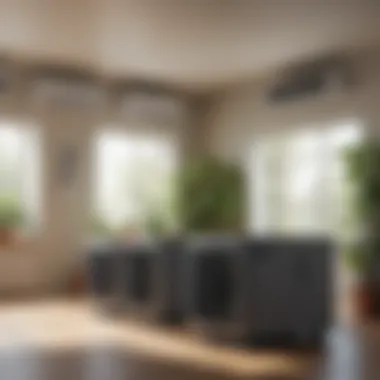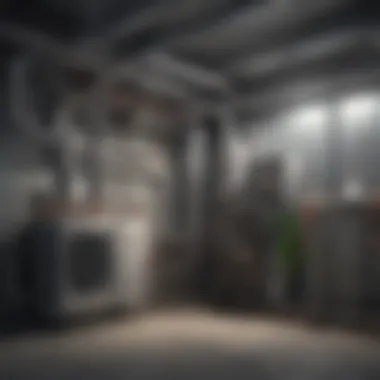Understanding the Costs of Replacing Central AC Systems


Intro
Replacing a central air conditioning system is a significant decision for any homeowner. Not only does it impact indoor comfort, but it also carries substantial financial implications. Understanding these costs can equip you to make more informed choices. This article seeks to unravel the key factors influencing the pricing of new systems, installation, and the long-term considerations associated with each choice.
The costs involved in replacing an air conditioning system vary widely due to multiple variables. These can include the type of system selected, labor costs for installation, and ongoing maintenance expenses. Delving into these factors will provide valuable insight as we proceed.
Design Inspirations
Trending Styles
When contemplating a new central air conditioning system, design considerations are essential. Modern units come in various styles that can blend seamlessly with your home’s aesthetics.
Energy-efficient options like the Trane XV20i and the Lennox XC25 prioritize both functionality and visual appeal. They are designed to be quieter than older models, which could enhance the ambiance of your living space.
Color Palettes
While air conditioning units are typically not the most prominent feature in a room, choosing colors that harmonize with your home's overall palette can enhance its visual integration. Neutral shades like white or light gray often blend well, while darker units can stand out, creating a focal point. This detail, while subtle, can affect the overall perception of your home’s interior.
Maintenance and Upkeep
Maintaining your air conditioning system is crucial for longevity and efficiency. Adequate upkeep will save costs in the long run, as neglected systems may lead to frequent repairs or even premature replacement.
Seasonal Maintenance Checklist
- Change Filters: Monthly during peak usage; at least every three months otherwise.
- Check Thermostat Settings: Ensure your unit is working as intended.
- Inspect Ductwork: Look for leaks or blockages.
- Schedule Professional Inspections: At least once a year to ensure optimal performance.
Cleaning and Organization Tips
A clean environment always benefits system performance. Regularly declutter around your outdoor unit and keep it free from debris. It can improve airflow and efficiency. Additionally, organizing indoor elements ensures that your thermostat and vents remain unobstructed.
Regular preventive maintenance can help avoid costly repairs and inefficiencies.
Foreword to Central Air Replacement
The decision to replace a central air conditioning system carries significant weight. It is not merely a matter of efficiency but also involves substantial financial implications. Understanding the costs linked with this replacement process is vital for homeowners. This section aims to set the tone for the entire discussion, highlighting what influences replacement costs and emphasizing the importance of informed decision-making.
The keywords such as "central air conditioning replacement costs" and "HVAC system efficiency" underpin the significance of this topic in the context of personal finance and home comfort.
Overview of Central Air Conditioning Systems
Central air conditioning systems are designed to keep indoor spaces cool, providing comfort during hot months. These systems work by circulating cool air through ductwork, powered by a compressor located outside the home. Understanding their operation involves recognizing the key components—evaporator coils, condenser coils, and the network of ducts.
Several factors play into how these systems perform, including their age, the technology used, and the regularity of maintenance. As systems age, their efficiency typically declines, leading to increased energy bills and the need for repairs. Homeowners should be aware of these aspects to keep ahead of potential issues.
This comprehensive explanation presents an opportunity to consider the compatibility of new systems with existing ductwork and whether updates are necessary or practical.
Importance of Regular Upkeep
Maintaining a central air conditioning system cannot be overstated. Regular upkeep ensures the efficiency of the system and prolongs its lifespan. Simple tasks such as changing air filters, cleaning ducts, and scheduling annual inspections can save homeowners significant amounts on energy bills over time.
Moreover, neglecting regular maintenance can lead to more severe problems, which may become too costly to repair. For example, clogged filters can strain the system, causing it to operate harder than necessary. This strain not only raises energy consumption but can also lead to premature system failure.
In essence, homeowners should view regular maintenance as an investment. It might involve some upfront costs, but the returns are realized through lower energy bills and extended system longevity.
"Investing in regular maintenance could prevent unexpected costs in the future, allowing for a smoother transition to any necessary replacements."


Now, as discussions move forward into specifics such as replacement costs, it is crucial to keep the importance of regular upkeep in mind. The health of the existing system heavily influences replacement decisions and associated expenses.
Understanding Replacement Costs
Understanding the replacement costs of central air conditioning systems is crucial for homeowners and design enthusiasts alike. The negotiation of price can be complicated by a variety of factors, and having a firm grasp on these elements aids in budgeting effectively. Knowledge of replacement costs helps in making informed choices that align with both immediate needs and long-term goals.
Factors Influencing Replacement Costs
System Type
The type of system you choose significantly influences the overall cost of replacement. Options such as split systems, packaged systems, and ductless mini-splits offer distinctive features that appeal to various needs. Split systems, for example, are popular due to their efficiency and flexibility in installation. However, their initial purchase price can be higher compared to other systems. Each type has unique installation needs and energy consumption characteristics that must be evaluated during the decision-making process.
Size and Capacity
The size and capacity of the air conditioning unit are fundamental to proper functionality and overall cost. Units are engineered to cool specific areas, meaning an oversized or undersized system can lead to inefficiencies. A correctly sized air conditioning unit functions more effectively, thus saving energy and lowering costs over time. It's essential to consult with a professional to assess the appropriate size you will require, as this greatly contributes to your satisfaction and operating expenses later.
Efficiency Ratings
Efficiency ratings are another crucial factor that should not be overlooked. Higher efficiency ratings, often indicated by SEER (Seasonal Energy Efficiency Ratio) values, correlate with lower energy consumption and reduced utility bills. Investing in a system with a superior efficiency rating might result in higher upfront costs but can lead to significant savings in the long run. The decision to prioritize efficiency is a matter of balancing immediate costs against potential savings.
Average Cost Estimates
Low-End Budget Options
For homeowners on a strict budget, low-end budget options are available. These systems usually come with a lower initial investment, making them an attractive option for many. However, it’s important to recognize that these cheaper units might not offer the durability or efficiency of higher-priced options. It can lead to frequent repairs or even early replacement. Consumers should weigh the upfront affordability against longer-term repair costs.
Mid-Range Solutions
Mid-range systems often present a balance between cost and efficiency. They typically offer better energy ratings than low-end options, ensuring a more reasonable energy bill in the future. Homeowners choosing these systems can typically expect a fair amount of longevity and reliability. Still, it is worthwhile to look into different brands and models as features can vary.
High-End Systems
High-end systems, while carrying a significant upfront cost, are known for their advanced technology and exceptional efficiency. These units often come with robust warranties and lower operational costs due to their superior performance. Though the initial investment is much higher, the overall savings on energy bills and maintenance may justify the expense. Such systems also frequently provide enhanced comfort control and quieter operation.
Labor and Installation Expenses
Labor and installation expenses are critical components of the total cost when replacing a central air conditioning system. Understanding these costs can help homeowners budget effectively and prevent unexpected financial burdens. The installation process not only involves the physical placement of the system but also considerations related to existing infrastructure, like ductwork and electrical systems.
Labor Costs Breakdown
Hourly Rates
Hourly rates for HVAC technicians vary widely based on experience and location. Generally, you can expect rates from $50 to $150 per hour. This variability is a critical aspect of budgeting for replacement costs. The benefit of hourly rates is that homeowners only pay for the time technicians spend working on their systems. Additionally, this method can foster transparency as clients can observe the work being done, ensuring they receive value for their money.
However, it can be disadvantageous if complications arise. Unexpected issues might lengthen the installation time, leading to higher overall costs. Clients should ask for estimates of how long the job will likely take to mitigate surprises.
Flat Rate Installations
Flat rate installations present an alternative to hourly rates, charging a set fee for the entire job regardless of time spent. Homeowners finding this option attractive appreciate the predictability it offers, allowing for easier budgeting. The flat rate covers labor as well as some predefined services involved in the installation.
Nonetheless, one must be careful with flat rate installations. If the installer encounters unexpected complications, this could reduce the quality of service or lead to incomplete work. Homeowners are encouraged to review what the flat rate includes, ensuring that all necessary aspects of installation are covered.
Installation Complexity
Installation complexity can significantly affect both labor and material costs, especially when existing systems need to be modified.


Type of Existing Ductwork
The type of existing ductwork plays a substantial role in installation costs. Well-maintained ducts may support the new system efficiently, while poorly maintained ducts can add to the costs significantly. For instance, older or rusted ducts may need repairs or replacements to optimize airflow. This can increase both labor and material expenses, demanding more skilled services to restore functionality.
Having compatible ductwork with the new HVAC system is essential for efficiency and proper air distribution. Older homes often require additional assessment to determine whether their duct systems can support modern air conditioning technologies.
Access Issues
Access issues can complicate installation greatly. If the area where the air conditioning system is to be installed is difficult to reach, this may necessitate more labor hours and specialized equipment. This includes scenarios where ductwork runs through tight spaces or attics that are not easily accessible.
Poor accessibility can lead to increased costs due to the extra time technicians spend managing these challenges. Furthermore, adequate planning is fundamental. Homeowners should communicate any potential access issues to contractors beforehand to obtain accurate estimates for the installation process.
"Understanding labor and installation costs is crucial when replacing your central air conditioning system. Lack of preparation often leads to increased expenses."
Evaluating both labor costs and installation complexity greatly aids in developing a comprehensive understanding of the total costs involved in replacing a central air conditioning system.
Long-Term Considerations
When contemplating the replacement of a central air conditioning system, long-term considerations become crucial. Investing in a new system is not solely about the initial outlay but also about the overall lifetime costs associated with energy efficiency, maintenance, and potential savings. It is imperative for homeowners to grasp how these elements interplay to substantiate their investment.
Energy Efficiency and Savings
SEER Ratings
The Seasonal Energy Efficiency Ratio, or SEER, is a critical metric in evaluating air conditioning systems. This rating signifies how efficiently an air conditioner operates over a typical cooling season. When a system has a higher SEER rating, it consumes less energy to provide the same level of cooling compared to lower-rated systems. For homeowners, this translates into lower utility bills, making high SEER ratings a beneficial choice.
One key characteristic of SEER ratings is their capacity to reflect long-term savings. Investing in a system with a high SEER rating might be pricier upfront, but the reduced energy costs can offset this in the long run. A unique aspect of SEER ratings is their ability to incentivize energy-efficient purchases. However, it is essential to consider the balance between initial costs and projected savings, as sometimes the most efficient models may not always be financially feasible for every homeowner.
Utility Rebates and Incentives
Utility rebates and incentives are financial offerings provided by local governments or energy companies to encourage the adoption of energy-efficient appliances, including air conditioning systems. These programs can significantly lessen the overall cost of replacement. By investing in a qualifying system, homeowners can avail themselves of rebates that effectively reduce upfront expenses.
This characteristic makes utility rebates quite appealing. Oftentimes, consumers can recoup a portion of their investment shortly after installation. Furthermore, these incentives can come in various forms, including cash rebates or tax credits, which enhances their appeal. However, potential disadvantages might arise, such as the complexity of qualification requirements or limited availability in certain areas. Homeowners should research available options to maximize their investment.
Maintenance and Upkeep Costs
Scheduled Maintenance
Scheduled maintenance is essential in prolonging the lifespan and efficiency of a central air conditioning system. Regular check-ups ensure that the system operates optimally, helping to prevent large-scale failures and from snowballing repair costs in the future. It is advisable to establish a maintenance plan with a qualified technician who can routinely inspect and service the unit.
One of the key benefits of scheduled maintenance is the predictability it brings. Homeowners often appreciate that minor issues are caught before they escalate. A secondary benefit is improved energy efficiency, which can lead to savings on utility costs. However, it's important to consider that scheduling maintenance may require a commitment of both time and financial resources, but these costs typically pale in comparison to the savings generated by avoided repairs.
Common Repairs
Understanding common repairs helps homeowners prepare for potential costs associated with their air conditioning systems. Issues like refrigerant leaks, malfunctioning thermostats, or clogged filters often arise during a system's lifecycle. Recognizing these common problems allows homeowners to proactively address them through routine inspections or timely repairs.
This aspect of common repairs emphasizes the importance of being knowledgeable about potential challenges. It not only helps in budgeting for unexpected expenses but also aids in identifying when it is necessary to replace parts or the entire system. On the downside, neglecting common repairs often leads to more severe problems, which can result in greater costs down the line. Thus, addressing these common repairs as they arise is critical for maintaining a functional and efficient air conditioning system.
Choosing the Right System
Choosing the right air conditioning system is a crucial step in the replacement process. Each system type offers unique benefits and considerations that can significantly impact efficiency, comfort, and overall cost. Homeowners need an informed approach when evaluating their options. The right choice can lead to substantial energy savings and improve indoor air quality. Moreover, understanding the features of various systems helps in making a decision that fits both the budget and personal preferences.
Evaluating System Types
Split Systems


Split systems are a popular choice among homeowners. These systems consist of an indoor unit and an outdoor condenser. A key characteristic of split systems is their ability to provide cooling without the need for extensive ductwork. This makes them ideal for homes lacking existing ducts.
The unique feature of split systems is their flexibility. They support a variety of configurations, allowing for installation in a range of spaces. One advantage is energy efficiency; many models come with high Seasonal Energy Efficiency Ratio (SEER) ratings. However, they may occupy more space outside the home, which could be a limitation in some areas.
Packaged Systems
Packaged systems combine all components into a single unit, typically installed on the roof or in a designated outdoor space. This system type simplifies installation and can save on space. Its key characteristic is its all-in-one design, making it suitable for homes with limited indoor space.
One unique feature of packaged systems is their ability to serve both heating and cooling needs, which can be beneficial in regions with significant temperature fluctuations. Additionally, they are generally more affordable in terms of initial installation costs. The downside could be their efficiency levels; some models might not offer the same energy rating as split systems, potentially leading to higher long-term costs.
Ductless Mini-Splits
Ductless mini-splits present another option, especially for homes that do not have ductwork. These systems consist of an outdoor compressor and one or more indoor air handlers. Their key characteristic is the zoning ability; each indoor unit can be controlled individually, allowing for personalized comfort in different areas.
The unique feature of ductless mini-splits is their energy efficiency, particularly when operating in smaller spaces. They often come with inverter technology that adjusts the compressor speed, promoting energy savings. However, their initial cost might be higher compared to traditional systems, making it essential to weigh this against potential energy savings over time.
Inventory of Local and Regional Contractors
When replacing a central air conditioning system, it is vital to find qualified contractors. Researching local and regional contractors will help ensure quality installation and maintenance. Start by checking online reviews and asking for recommendations from friends or family. Also explore platforms like Reddit and Facebook to see discussions about contractor experiences.
Compare quotes from different contractors, looking for transparency in pricing and the scope of work. This can reveal the true cost of installation which might be different than initial estimates. A qualified contractor will help in selecting the right system based on specific needs and local climate conditions.
Financing Options for Replacement
When considering the replacement of a central air conditioning system, financing options play a crucial role. The decision to replace an HVAC system involves substantial financial commitment. Homeowners need to evaluate and understand various financing methods available to them. Using financing options can ease the burden of upfront costs. Knowing how to manage these expenses can lead to better financial planning and long-term satisfaction with the investment.
Cash Purchase vs. Financing Plans
Making a decision on whether to pay cash for a new system or to explore financing can be daunting. Here are a few key points to consider:
- Cash Purchase: Paying outright provides a sense of ownership. There are benefits, such as avoiding interest payments and fees associated with loans. However, immediate cash flow may be affected. Homeowners need to ensure they can afford this without sacrificing other essential expenses.
- Financing Plans: Financing allows you to spread out the cost over time. This can make new systems more accessible, especially if cash on hand is limited. Options vary, from zero-interest plans to longer terms with varied rates. It's critical to compare offers and terms before committing. Remember to consider any potential fees involved in financing. A lower interest rate may not always lead to better value if fees are high.
In summary, choosing between a cash purchase and financing depends on individual financial situations and preferences. Consider long-term impacts carefully.
Understanding Credit Options and Loans
Exploring credit options and loans is essential for homeowners who consider financing to pay for their new central AC system. Several pathways exist, each with unique terms and requirements:
- Personal Loans: Generally unsecured and can be obtained quickly. They tend to have higher interest rates compared to secured loans.
- Home Equity Loans: These are secured by the equity in a home, typically offering lower interest rates. However, they carry the risk of losing the home if payments are not maintained.
- Credit Cards: This can be an option if the limit is high and interest rates are manageable. Some cards offer promotional 0% interest rates for a specific time.
- Specialized HVAC Financing: Some contractors may offer financing options specifically designed for HVAC systems. These often come with flexible payment terms and reasonable interest rates.
When considering financing, it is vital to evaluate the total cost. Look beyond monthly payments. Ensure you understand the overall expense, including interest, fees, and potential penalties for late payments.
The financing option chosen can greatly affect the financial outcome of your investment.
Ending
In the context of replacing central air conditioning systems, the conclusion serves an essential purpose. It encapsulates the core themes discussed throughout the article and reiterates the significant factors that influence both the costs and the decision-making process for homeowners. Understanding these elements not only sheds light on the monetary implications but also emphasizes the importance of selecting the right system that aligns with individual needs and circumstances.
Summary of Replacement Costs and Options
When contemplating the costs associated with replacing a central air conditioning system, it is vital to appreciate the multifaceted nature of these expenses. Key components include:
- Type of System: Different systems such as split, packaged, or ductless mini-splits present varying price points and functionalities.
- Installation Costs: This can vary widely based on labor rates and the complexity of the installation applicable to existing ductwork.
- Efficiency Ratings: Systems with higher SEER ratings may have a higher initial cost but can lead to substantial energy savings over time.
Overall, average replacement costs can encompass a range from low-end budget options to high-end premium systems. Homeowners should consider their specific requirements, geographic location, and available contractors when evaluating potential costs. This diligence aids in making an informed choice that balances upfront investment with long-term benefits.
Final Recommendations for Consumers
In making a decision about replacing a central air conditioning system, homeowners should follow a series of practical steps:
- Evaluate Energy Needs: Assess the size and design of your home to determine the capacity required for effective cooling.
- Research Systems: Investigate the different types and brands available in the market, focusing on reviews and efficiency ratings.
- Compare Quotes: Seek multiple quotes from local contractors to get a clear picture of installation costs and labor rates.
- Consider Financing Options: If initial costs are a concern, explore financing plans that help to spread out expenses over time.
- Inquire About Maintenance: Understand the ongoing maintenance requirements and costs of different systems to anticipate future expenses.
By incorporating these recommendations, consumers can navigate the complexities of AC system replacement with greater assurance. This meticulous approach promotes long-term satisfaction and operational efficiency, ultimately safeguarding one's investment.







